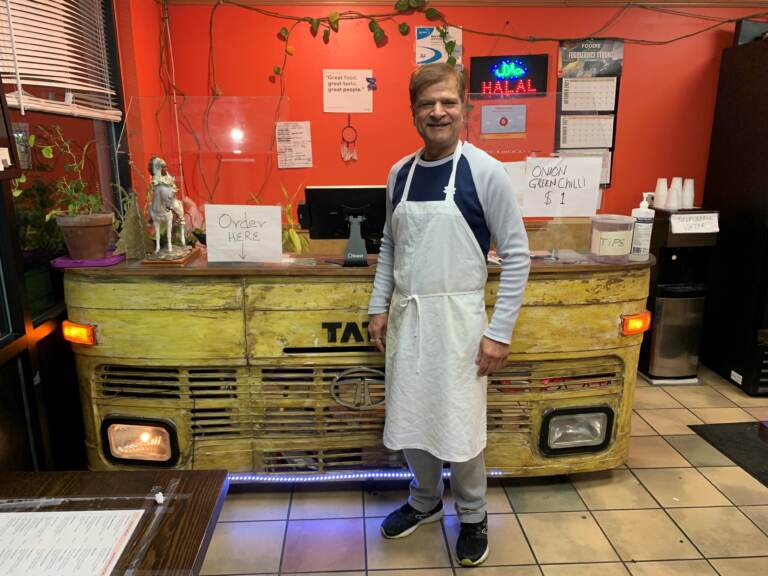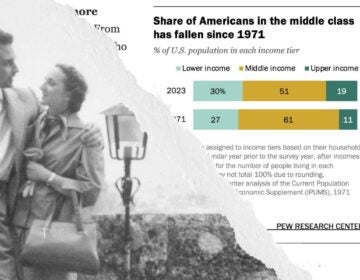Fewer immigrant workers are coming to fill key jobs. That has slowed the U.S. economy

Jagdeep Nayyar, owner and chef at My Taste of India, stands in front of the register stand that's made from the front panel of a real Tata truck — the best-selling brand in India. (Joel Rose/Joel Rose)
From the moment you walk through the door of Jagdeep Nayyar’s restaurant near I-81 in Central Pennsylvania, it’s clear who his customers are.
The cashier’s stand is fashioned from the front panel of a real Tata truck — the best-selling brand in India.
“Every American food is available on every exit,” Nayyar tells NPR in an interview. “So it came to my mind, why not open an Indian restaurant?”
A few years ago, Nayyar closed the Subway franchise that used to occupy this truck stop near Harrisburg and Hershey, and opened My Taste Of India. It’s one of a growing number of roadside restaurants around the country that cater primarily to truckers with roots in the northwest Indian state of Punjab.
Employers in the U.S. are struggling to fill roughly 11 million open jobs. The pandemic gets most of the blame, but there’s a related factor that gets less attention. Fewer immigrants are coming to fill those jobs — particularly in some key industries that keep the economy moving.
The U.S. economy is missing more than 1 million immigrant workers because of the pandemic
“If you can’t get the key workers you need, the whole industry slows down. And the whole economy slows down,” says Jeremy Robbins, executive director of the American Immigration Council.
Robbins says the U.S. economy is missing more than 1 million immigrant workers who would otherwise be here — were it not for the pandemic, and steep cuts to legal immigration during the Trump administration. And he argues that slowdown in immigration may be contributing to supply chain problems and inflation, as employers struggle to find enough workers.
“That has a real impact,” Robbins says in an interview. “Not just on [workers] themselves, and not just on the industries that they are going to work on, but on the whole economy.”
Some industries may be feeling this shortage even more acutely. The food service and healthcare industries, which both depend heavily on immigrant workers, have more than a million open jobs. There are hundreds of thousands of openings in the trucking and warehousing industry, where roughly one in five workers are foreign-born.
Punjabis have taken to trucking in a big way, making up as much as a fifth of the industry in the U.S.
On a recent evening, a steady stream of Punjabi drivers pulled over for dinner at My Taste Of India.
“I just stopped for the food. Here is a good Punjabi restaurant,” said Gurtaj Singh, on his way to Kentucky. “Everything they make very nice.” Singh has only been driving a truck for 15 months, he said, but has already learned where to find roadside restaurants all over the country through word of mouth.
“The Punjabi community getting into the trucking is like enormous numbers,” says Raman Singh Dhillon, the head of the North American Punjabi Trucking Association. “It’s in the blood.”
In Fresno, Calif., where Dhillon lives, there’s a longstanding Punjabi community. Over the past decade, Dhillon says, Punjabis have taken to trucking in a big way, and now make up as much as a fifth of the industry nationwide.
But Dhillon says that growth has been limited in the last few years, as the coronavirus put the brakes on the U.S. immigration system.
“There’s a whole lot of people that should have entered the country legally [who] were not able to enter. I have several people around me that their family members are stuck in India because their interviews are not done,” he says. “And a lot of these newcomers, when they come in, their preferred industry to join is trucking.”
It’s widely agreed that fewer immigrants entered the U.S. labor force last year — but not everyone thinks it’s a problem.
Immigration restrictionists welcome the slowdown
“My point is, that’s good. Labor tightness is good,” says Roy Beck, the founder and president of NumbersUSA, a nonprofit in the Washington, D.C., area that pushes for lower levels of immigration, and the author of a new book called Back Of The Hiring Line: A 200-Year History of Immigration Surges, Employer Bias, and Depression of Black Wealth.
“It is proven that you tighten the labor market and wages go up. It always happens,” Beck says. “The fact that we had one year of less immigration contributed to that. And that’s good. It’s one of the most positive things that could happen for tackling economic inequality.”
Beck argues that too much immigration hurts native-born workers, particularly those with less education, though many economists say the effect is small.
By all accounts, there are other, bigger reasons for the current labor shortage — with millions of workers retiring, or reluctant to come back to work during the pandemic. But it would be a mistake to ignore the effects of immigration, says Karthick Ramakrishnan, who teaches public policy at the University of California, Riverside.
“If you had a slowdown in immigration when there’s very little demand for labor, you’re not going to see that much of an effect. But because we saw a lot of demand for labor even before the pandemic, and that has only accelerated,” Ramakrishnan says.
Right now — with millions of job openings — Ramakrishnan says there is a lot of demand for labor. “So absolutely. The slowdown in immigration is making a difference,” he says.
The absent immigrants wouldn’t fill all those open jobs, he says. But they might help.
9(MDAzMzI1ODY3MDEyMzkzOTE3NjIxNDg3MQ001))




